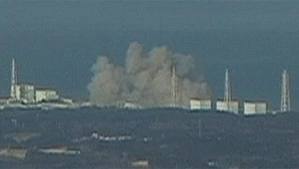
This article was last updated on April 16, 2022
Canada: ![]() Oye! Times readers Get FREE $30 to spend on Amazon, Walmart…
Oye! Times readers Get FREE $30 to spend on Amazon, Walmart…
USA: ![]() Oye! Times readers Get FREE $30 to spend on Amazon, Walmart…
Oye! Times readers Get FREE $30 to spend on Amazon, Walmart…
 There has been an explosion at the Fukushima I Nuclear Power Plant located in the town of Ōkuma, about 260 kilometres north of Tokyo. This town has a population of approximately 11,000.
There has been an explosion at the Fukushima I Nuclear Power Plant located in the town of Ōkuma, about 260 kilometres north of Tokyo. This town has a population of approximately 11,000.
According to reports, after the quake, reactors were automatically shut down however the resulting tsunami damaged backup generators for the cooling systems. A nuclear emergency was declared and people were ordered to evacuate, first within a 3 kilometre radius but this has now been extended to 20 km.
At midnight Friday, the Tokyo Electric Power Company was considering the venting of hot gas from the reactor vessel. Not only had radiation levels, but pressure from the heat was exceeding design capacity. Such venting could release some radiation into the atmosphere. Reports state that some potentially radioactive steam was vented from into a secondary containment but it is unclear if this was released outside.
At 4:30pm local time on Saturday, an explosion occurred at the plant. Televised video showed the explosion and white smoke rising from the facility. Reuters is reporting that the blast blew the roof off, radiation has now leaked, and authorities may distribute iodine to people in the vicinity to protect them from exposure. Apparently 4 workers were injured in the explosion.
The government is insisting that radiation levels are low. While the explosion has damaged the main building of the plant, the reactor core container remains intact. Obviously the worry for everyone is seeing anything comparable to Chernobyl in 1986. In that disaster, a reactor vessel ruptured exposing radioactive components to the air which due to the intense heat, ignited. The resulting fire sent a plume of radioactive fallout into the atmosphere which drifted over a wide area including both the Soviet Union and parts of Europe. Large areas of the Ukraine, Belarus and Russia had to be evacuated and 4.000 deaths were attributed to the disaster.
As for the cause of the explosion, Reuters is also reporting that the experts are theorising this could have been from hydrogen igniting. They add that "If the hydrogen has ignited, then it is gone, it doesn’t pose any further threat. As far as we know there is no particular danger from radiation leaks." These statements which contain the word "may" quite frequently indicate that nobody knows for sure what’s happened and what’s currently going on at the plant. Uncertainty is the watchword of the day.
The BBC has analysed the various aspects of the situation based on the reports coming out of Japan about what various officials have said publicly. The conclusion is that there are more questions than answers. Safety systems are supposed to work "in principle". Multiple redundancies should ensure functioning in the case of one failure. However in this case, while the reactors shut down because of the quake, the tsunami supposedly knocked out the generators meant to supply power to the water pumps which send cooling water around the hot core. No cooling, the reactors overheat. Even though a reactor is shut down, it continues to generate heat for quite some time; shutting it down is not like turning off a light switch. You turn it off and it winds down over some time.
ITN News – Mar 12/2011
Explosion rocks Japan nuclear plant
There has been an explosion and radiation leakage at a nuclear power plant in north east Japan.
http://www.youtube.com/watch?v=Eofr1Js6nLg
Click HERE to read more from William Belle
Article viewed at: Oye! Times at www.oyetimes.com

Be the first to comment